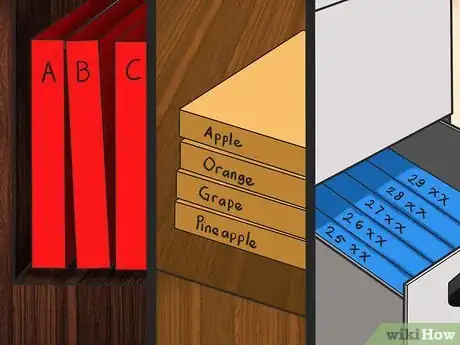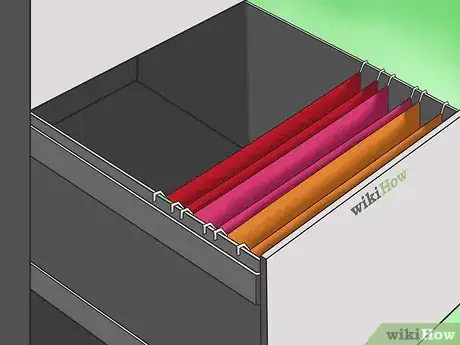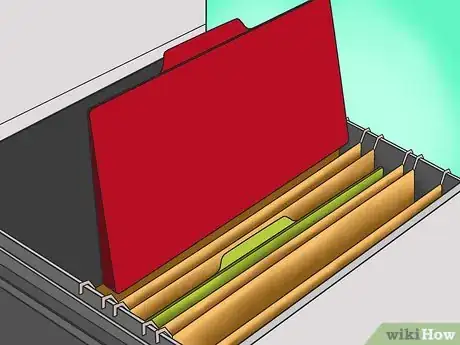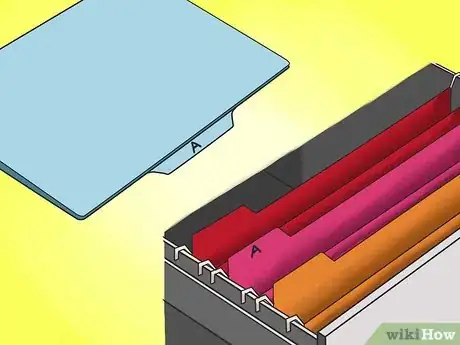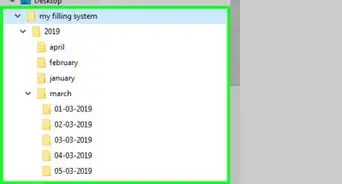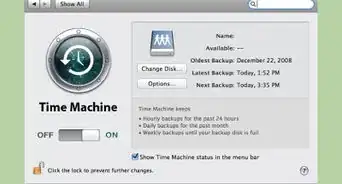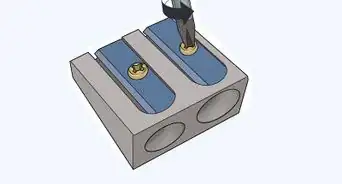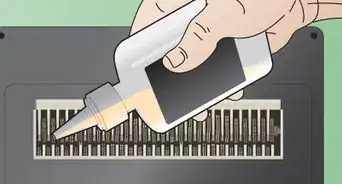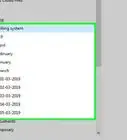This article was co-authored by Kerri Christensen. Kerri Christensen is a Cleaning & Organization Specialist and the Owner of Busted Knuckles Cleaning. With more than seven years of cleaning experience, she specializes in helping others make their homes a cleaner place. Kerri holds a Bachelor’s in Human Resources Management and Services from Western International University.
wikiHow marks an article as reader-approved once it receives enough positive feedback. This article has 12 testimonials from our readers, earning it our reader-approved status.
This article has been viewed 357,995 times.
Few things are more important to a smooth-running office than a filing system that works. Whether you are the only one accessing files or you share with a staff, the filing system you choose must be organized so everyone can find what they're looking for. If the filing system is difficult to use, you will hang onto papers for fear of losing them in the files, and you'll soon have piles of papers covering your desk.
Steps
-
1Decide on a filing system. Whatever it is, it must make sense, so you'll know exactly where every piece of paper is. Your options are:[1]
- Alphabetical. This system is best when most of your files are going to be names of clients, patients or customers.
- Subject or category: Most file systems are organized by subject or category, which works well when set up correctly, but can also be the most confusing when it's not.
- Numerical/Chronological. This best when your files consist mainly of numbered or dated material, like purchase orders or receipts.
-
2Fill your file drawers with hanging folders. The hanging folders will never be removed, acting as place holders for the manila envelopes which you will remove from the drawer.Advertisement
-
3Sort your papers into piles by category. If a pile gets more than an inch or two tall, divide it into subcategories. If a pile is too thin, combine it with another pile and rename it. The names of the piles should make it easy to determine which pile every piece of paper goes into.[2]
-
4Place each pile into a manila folder and label it clearly. It's best to use folders with tabs that are in the center rather than staggered because it makes the files look neater.[3]
-
5Place the manila folders into the hanging folders. For most files, regular hanging folders will work, but for thick files or files you had to divide into subcategories, use box bottom folders. You can order the folders however you want, but most people use an alphabetical system at this point.
-
6Label the hanging folders with the same names as the manila folders. Place all the plastic tabs on the left of the folder unless you are using a lateral file cabinet. For lateral files, which run left to right when you open the drawer rather than front to back, place the tabs on the right side.
-
7Place a supply of hanging and manila folders near the files so you can easily add a folder if you find yourself with a piece of paper that doesn't belong to an existing folder. Avoid folders that are too thick or too thin. You may also want to relabel folders and redistribute papers if you decide that you need to re-categorize.
-
8At the end of the year, remove all the folders, label fresh manila folders with the same category names and place them in the files. Go through the old folders to see if anything needs to be transferred to the current files, and place the rest in your archive.[4]
Community Q&A
-
QuestionWhat could I use when pulling a file?
 Community AnswerConsider having an "Out" card (a large index card) in each folder for signing out files. The person taking the file must write his or her initials as well as the date on the card. This will allow you to track down lost or missing files.
Community AnswerConsider having an "Out" card (a large index card) in each folder for signing out files. The person taking the file must write his or her initials as well as the date on the card. This will allow you to track down lost or missing files. -
QuestionCan I categorize the files according subject area?
 Community AnswerYes! The purpose of categorizing files is so that you can find them easily. If categorizing files according to subject is easier for you, then you should do it!
Community AnswerYes! The purpose of categorizing files is so that you can find them easily. If categorizing files according to subject is easier for you, then you should do it! -
QuestionWhat if a file can go into more than one category? For example, car insurance can go into the 'Car' or the 'insurance' folder. How can I simplify this system?
 Community AnswerFile the actual folder under insurance and put a sheet of paper in the "car" folder that says, "See 'insurance' file for car insurance information."
Community AnswerFile the actual folder under insurance and put a sheet of paper in the "car" folder that says, "See 'insurance' file for car insurance information."
Warnings
- Never create a miscellaneous pile for what you can't categorize, because everything will end up there.⧼thumbs_response⧽
- Once you've established a filing system, you must keep up with your filing. Set aside time each day to take papers from your desk and file them. Resist the temptation to set a deep filing basket on top of your files, because you'll just fill it up, and it will become another file.⧼thumbs_response⧽
References
- ↑ https://bizfluent.com/list-7639382-various-filing-classification-systems.html
- ↑ https://www.indeed.com/career-advice/career-development/organize-your-paperwork
- ↑ https://www2.education.vic.gov.au/pal/records-management/guidance/best-practice-archiving-hardcopy-records
- ↑ https://www2.education.vic.gov.au/pal/records-management/guidance/best-practice-archiving-hardcopy-records
- ↑ https://www.indeed.com/career-advice/career-development/organize-your-paperwork
